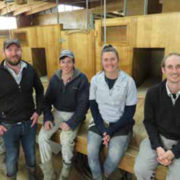Rapid development and deer expansion at Melior Venison
Day two of this year’s Next Generation Programme saw delegates descend from the Mackenzie Basin to Melior Venison, an 800-hectare partially irrigated property east of Fairlie where Tom and Samantha Macfarlane with Tim and Sarah Turner plus a team of young staff have driven a rapid development programme.
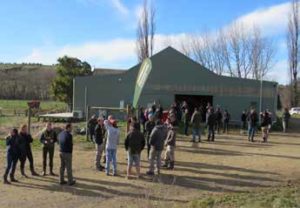
Morning muster: Next Generation delegates gather in the yard at Melior Venison, South Canterbury.
IN JUST OVER six years, deer have gone from 10 percent of the farming system to 80 percent at Melior Venison (formerly reported in Deer Industry News as The Kowhais) in the rolling hills between Fairlie and Pleasant Point, South Canterbury.
The rapid development programme has also seen stock units wintered lifted from 7,000 to 11,000. Poor quality ryegrass/ browntop pasture in the paddocks has been replaced with highperforming herb and grass mixes while hill blocks of browntop and scrub have been broken in with heli-cropping and hoof and tooth techniques.
“We’ve put in 100km of deer fencing and 95 percent of the farm is deer fenced now,” Tom Macfarlane told the Next Generation visitors in his opening comments.
The Macfarlanes run the farm, which is owned by John and Melinda Macfarlane, with the help of farm manager Tim Turner and three other permanent staff. They also have a 50 percent stake in, and manage, the 490-hectare former Deer Improvement business in Southland, now branded Melior Genetics.
They’re a young team, with Tom the oldest at 31. Farm manager Tim is 27, having joined the business as a shepherd on leaving Lincoln six years ago. The other three are all in their teens or early twenties.
“I’m quite committed to employing young staff,” Macfarlane said, “both for their attitude and because I believe we need to ‘give back’ to the industry, not just sit and complain about lack of staff. We’ve got to train people.”
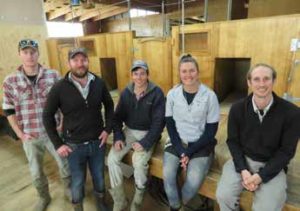
Melior Venison’s team, from left: Hamish Brown, Tom Macfarlane,
Mitchell Cross, Maddi Palmer and Tim Turner.
Macfarlane noted they had to ensure their employment offer was compelling compared with dairy, where rosters locally were now more often five and two, rather than 11 and three days on and off. Being able to offer reasonable accommodation was also important and they’d converted part of the unused woolshed to a new two bedroom flat in order to be able to do that.
They try to minimise weekend work, but winter feeding and 180 hectares of irrigation including guns, a roto-rainer, a lateral and K-line, means someone is needed seven days a week for most of the year.
A 50,000m3 pond installed when they took on the property has allowed that irrigated area to be increased from 140 hectares without increasing their shareholding in the Opuha Water irrigation scheme. The pond provides flexibility, allowing them to take 100 percent of their 65 litre/second allocation continuously
Melior Venison key points
• 800ha (650ha effective, 180ha irrigated) mixed country near Fairlie, South Canterbury.
• Major pasture and fencing development past 6 years – now 95 percent deer fenced.
• Deer: 1,200 hinds, 4,000 weaners, 60 sire stags.
• Beef: transitioning from Friesian bulls to beef herd plus finishers.
• Sheep: lambed 400 annual draft ewes. Replacement with hinds likely.
Fescue, clover and plantain permanent pastures.
while actual use on farm ranges from 0–100 litres/ second. It also means if they get unexpected rain they can turn irrigators off immediately but still take and store water already released from Lake Opuha on their behalf.
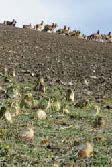
Fodder beet is direct drilled to minimise risk of soil loss – at sowing and grazing.
“There’s a 36-hour lag for the water in the river to get from the lake to the farm,” Macfarlane explained.
The irrigation is all on one side of the farm and mostly goes on light river flat soils, with a little available for application through gun and K-line on heavier clay terraces. The whole area is used to grow winter crops and high-quality finishing feeds in a roughly five-year rotation.
Direct drilling is used extensively, including for fodder beet, to minimise cost and environmental risk from erosion both at planting and feeding. The savings come not only in operations, but also in agrichemicals, notably herbicides.
“We spent $436/ha on [fodder beet] chemicals last year whereas it was $700/ha when we cultivated,” Turner pointed out to the field day.
Beet yield this winter was disappointing at 16tDM/ha due to a very wet spring and early summer but with 13–14tDM/ha of that eaten at a total growing cost of $1426/ha it was still competitive.
“The previous year we did 21t/ha down the throat … we did spend a little bit more but it was still under 10c/kgDM,” added Macfarlane.
To date they’ve mostly grown soft, low drymatter types, such as Feldherr, fearing harder varieties could cut hind longevity. Macfarlane noted his deer in Southland, which are the same genetics as at Melior Venison, and on very similar soils, have much worse teeth. This, he suspected, was down to historic grazing of HT Swedes, which were particularly hard.
“It’s the only thing I can put my finger on for the difference. By nine or ten years they’re pretty gummy.”
All hinds are mouthed at weaning and any substandard animals are culled. Talking to people around the country he finds those who don’t mouth hinds often also have higher empty rates and a lot of lighter hinds.
“Farmers are aiming for longevity but sometimes they’re robbing Peter to pay Paul: they’d be better off biting the bullet and replacing them with good quality young stock.” The longer hinds are kept, the slower the generation interval so the slower the genetic gain, he added. “It’s all about finding the right balance.”
From just 700–800 weaners when they took over the South Canterbury farm, it now supports 1,200 hinds and finishes 4,000 weaners. They’re looking to increase the breeding herd to 1,500, reducing reliance on buying in weaners and the risks associated with that.
Hill blocks on the south side of the farm – the far side from the irrigation – have been fenced so they each open directly onto a lower-lying paddock making it easy to move stock from open, high-quality pasture to rougher grazing and/or more cover.
Macfarlane said a lot of the farm is marginal for fawning and long-term he’d like to have some fawning cover in every paddock with a patch of sparsely planted trees, preferably a species favoured for browsing by deer.
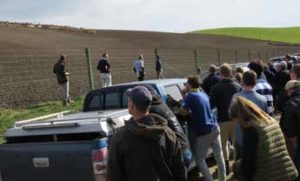
A stop to view hinds on fodder beet spurred a discussion on mouthing
and longevity.
Hawke’s Bay farmer and DFA Executive Committee member Grant Charteris noted over-stocking and hinds fighting for fawning spots is the biggest contributor to fawn losses, and Macfarlane added that in Southland last year he’d deliberately lifted the mower for about 20m occasionally when cutting silage to leave long patches randomly dotted across the paddock ready for fawning.
“It looked terrible, but when they were fawning you’d see the hinds running back to these patches … I think it worked because our fawning percentage was a lot higher than the previous year.”
Monitoring of stock performance is facilitated by EID tags and data recording on FarmIQ or, in the Southland business, Mihub.
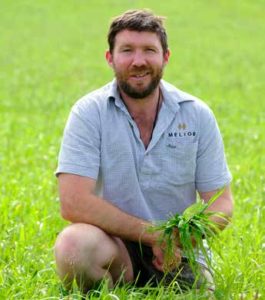
Tom Macfarlane photographed earlier this year showing the type of
pasture mix they are now favouring at Melior Venison.
“You’ve just got to pick which package is best for you but the point is, information is power,” said Macfarlane. “If we don’t record what we’re doing now, how are we going to know what progress we’ve made in five years’ time?”
Charteris echoed that, adding such packages also make compliance with farm assurance schemes much easier.
“Use the technology to your advantage,” he urged the Next Generation attendees.
Charteris also revisited the employment and staffing discussion that had kicked off earlier on the farm tour, warning delegates
“there’s a fine line between expectation and reputation” for young staff in the industry and reputation had to come first.
Build that, through hard work, good decisions and smart networking, and opportunities would follow.
Macfarlane, who has been to Lincoln to speak to students about opportunities in the sector, said he’d always try to find room in his team for the right person.
“There’s a very good career in managing farms.”
Fescue preferred
Pasture development at Melior Venison has seen most paddocks sown in fescue rather than ryegrass, typically with some prairie grass included to boost winter/early spring growth, plus 5kg of red clover, 3kg of white clover, and 4kg of plantain.
Fescue is preferred for its greater drought tolerance – 60cm root-depth as opposed to 30–40cm for ryegrass, Macfarlane noted – and productivity in the heat of summer.
However, the fescue mix is only deployed once a paddock has been through a couple of years of red clover or other forages to ensure weed grasses and old high-endophyte ryegrasses are eliminated.
“There’s no point spending a heap of dollars on a fescue mix if you’re going to get a whole lot of weed grasses coming into it,” Macfarlane told the field day, reflecting on fescue’s slower establishment than ryegrass.
They’ve found with careful management – not grazing for more than five days and never “hammering to the ground” – they can make red clover stands last several years. And it doesn’t matter too much if the clover stand gets a bit long, added Macfarlane. This is because forage quality is still reasonable thanks to clover stems’ ME of about 10MJ/kg, unlike ryegrass where the ME drops dramatically once it runs to seed.
Nitrogen fertiliser is used sparingly on pasture, typically just 30kgN/ha applied early in spring on the non-irrigated land to help get things away, often going on with the annual maintenance fertilisers. On irrigated land in pasture, three or four top-dressings of 60–70kg/ha of urea is the norm.
Forage crops for ensiling, such as barley and peas, and pure stands of red clover for ensiling and/or finishing stock with, are also grown under irrigation.
Bulls out, cows in, ewes going?
Having finished Friesian bulls for five years, a 150-head beef breeding herd is being built up to replace them in the stock mix by buying in heifers and also breeding their own from dairy-beef cross heifers put to Angus bulls. The dairy-cross heifers will be sold for beef as once-bred heifers after the calves are weaned.
While the Friesian bulls were profitable, the cows and followers would be a better fit with the deer operation and consequently more profitable overall, Macfarlane told the field day.
Also on the way out, it seems, is the ewe flock, which has gradually been pared down as pastures have been improved and deer fencing extended. From a flock of 2,500 when they took over the property six years ago, just 400 were lambed this spring and none of those were from the original flock.
“We’ve been buying in annual draft ewes for the past three years.”
Deer health regime
Hinds at Melior Venison get an annual seven-in-one clostridial booster, copper bullets, and iodine pre-mating but are never drenched or, if they have to be for welfare reasons, they’re subsequently culled.
All weaners are drenched with a triple-active during autumn and closely monitored for lungworm, with an injection of selenised vitamin B12 given at the first drench post weaning.
Home-bred weaners get Yersinia, Leptospirosis and clostridial (Covexin) vaccinations, plus copper bullet.

